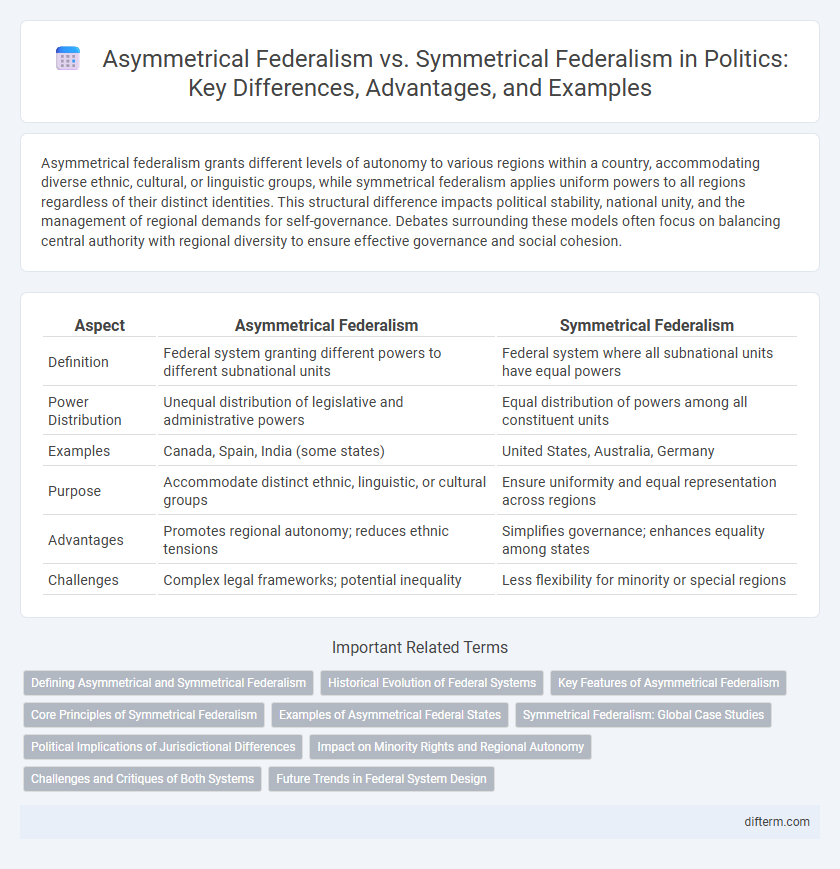Asymmetrical federalism grants different levels of autonomy to various regions within a country, accommodating diverse ethnic, cultural, or linguistic groups, while symmetrical federalism applies uniform powers to all regions regardless of their distinct identities. This structural difference impacts political stability, national unity, and the management of regional demands for self-governance. Debates surrounding these models often focus on balancing central authority with regional diversity to ensure effective governance and social cohesion.
Table of Comparison
| Aspect | Asymmetrical Federalism | Symmetrical Federalism |
|---|---|---|
| Definition | Federal system granting different powers to different subnational units | Federal system where all subnational units have equal powers |
| Power Distribution | Unequal distribution of legislative and administrative powers | Equal distribution of powers among all constituent units |
| Examples | Canada, Spain, India (some states) | United States, Australia, Germany |
| Purpose | Accommodate distinct ethnic, linguistic, or cultural groups | Ensure uniformity and equal representation across regions |
| Advantages | Promotes regional autonomy; reduces ethnic tensions | Simplifies governance; enhances equality among states |
| Challenges | Complex legal frameworks; potential inequality | Less flexibility for minority or special regions |
Defining Asymmetrical and Symmetrical Federalism
Asymmetrical federalism grants varying degrees of autonomy to different constituent regions or states within a country, often to accommodate distinct ethnic, linguistic, or cultural communities. Symmetrical federalism, by contrast, provides equal powers and responsibilities to all subnational units under a uniform constitutional framework. The choice between these models significantly impacts political stability and governance effectiveness in diverse federations.
Historical Evolution of Federal Systems
Asymmetrical federalism evolved to address the unique cultural, ethnic, or linguistic differences within states by granting varying degrees of autonomy to certain regions, exemplified by Canada's accommodation of Quebec's distinct identity. Symmetrical federalism, seen in countries like the United States and Australia, promotes uniform authority and power distribution across all constituent units, aiming for equal regional representation and governance. The historical evolution of federal systems reflects attempts to balance unity with diversity, shaped by colonization, revolutions, and constitution-making processes.
Key Features of Asymmetrical Federalism
Asymmetrical federalism features distinct powers and autonomy granted to specific subnational units, often to accommodate linguistic, ethnic, or cultural diversity within a single state. Unlike symmetrical federalism, where all regions have equal authority, asymmetrical federalism allows certain provinces or regions to exercise unique legislative, fiscal, or administrative powers tailored to their particular needs. This model promotes political stability and unity by recognizing and institutionalizing regional differences within a federal system.
Core Principles of Symmetrical Federalism
Symmetrical federalism is defined by the equal distribution of powers and responsibilities among all constituent states or regions, ensuring uniform legal and political status. Each region operates under the same constitutional powers, promoting national unity and reducing regional disparities. This core principle contrasts with asymmetrical federalism, where certain regions receive unique powers based on historical, cultural, or political considerations.
Examples of Asymmetrical Federal States
Asymmetrical federal states include Canada, where Quebec has distinct powers compared to other provinces, and Spain, where Catalonia enjoys greater autonomy than other regions. India also exemplifies asymmetrical federalism with states like Jammu and Kashmir historically granted special status under Article 370. These examples demonstrate how asymmetrical federalism accommodates diverse ethnic, linguistic, or cultural groups within a single federal system.
Symmetrical Federalism: Global Case Studies
Symmetrical federalism features uniformity in the division of powers and responsibilities across all constituent units, exemplified by countries like the United States, Germany, and Australia. In these nations, each state or province enjoys equal constitutional status and authority, fostering national unity and consistent policy implementation. This system contrasts with asymmetrical federalism by maintaining standardized governance structures and equal autonomy among all federal entities.
Political Implications of Jurisdictional Differences
Asymmetrical federalism creates distinct jurisdictional powers for regions, often accommodating cultural or ethnic diversity, which can stabilize political tensions but risk unequal representation. Symmetrical federalism enforces uniform jurisdictional authority across all regions, promoting equality but sometimes overlooking local needs and identities. The political implications of these differences influence governance effectiveness, regional autonomy, and the balance of power within a federation.
Impact on Minority Rights and Regional Autonomy
Asymmetrical federalism grants distinct powers and autonomy to specific regions or minority groups, effectively protecting their cultural identity and political rights within a unified state structure. Symmetrical federalism applies uniform governance across all regions, which can sometimes marginalize minority interests due to the lack of tailored legal frameworks. The choice between asymmetrical and symmetrical federalism significantly influences regional autonomy levels and the safeguarding of minority rights in multiethnic or multicultural nations.
Challenges and Critiques of Both Systems
Asymmetrical federalism faces challenges in creating perceptions of inequality among regions, potentially fueling separatism and complicating national unity, while symmetrical federalism often struggles to address diverse regional needs equally, risking inefficient governance. Both systems encounter critiques regarding their impact on political stability, with asymmetrical arrangements criticized for fostering institutional complexity and symmetrical structures accused of imposing uniform policies that may not suit local contexts. Balancing regional autonomy and national cohesion remains a persistent difficulty in both federalism models, affecting policymaking and intergovernmental relations.
Future Trends in Federal System Design
Future trends in federal system design emphasize increasing adoption of asymmetrical federalism to accommodate diverse regional identities and autonomy demands more effectively than symmetrical federalism. Governments are leveraging asymmetrical arrangements to balance national unity with localized governance, allowing tailored policy-making that addresses unique economic, cultural, and political contexts. Emerging challenges such as globalization, migration, and technological change are driving federal systems to evolve towards more flexible, asymmetric models that enhance resilience and democratic representation.
asymmetrical federalism vs symmetrical federalism Infographic

 difterm.com
difterm.com